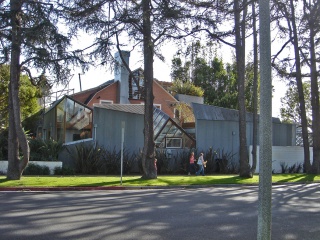Education | Timeline |
- 1829
- 1834
- 1840s
- 1848
- 1853
- 1859
- 1870
- 1870s
- 1871
- 1875
- 1877
- 1879
- 1880s
- 1882
- 1883
- 1884
- 1886
- 1887
- 1889
- 1890s
- 1891
- 1892
- 1893
- 1894
- 1895
- 1898
- 1899
- 1900
- 1900s
- 1901
- 1902
- 1904
- 1905
- 1906
- 1908
- 1909
- 1910
- 1910s
- 1911
- 1912
- 1913
- 1914
- 1915
- 1916
- 1917
- 1918
- 1919
- 1920
- 1920s
- 1921
- 1922
- 1923
- 1924
- 1925
- 1926
- 1927
- 1928
- 1929
- 1930s
- 1930
- 1931
- 1933
- 1934
- 1935
- 1936
- 1937
- 1938
- 1939
- 1940s
- 1940
- 1941
- 1942
- 1943
- 1944
- 1945
- 1946
- 1947
- 1948
- 1949
- 1950s
- 1950
- 1951
- 1952
- 1953
- 1954
- 1955
- 1956
- 1957
- 1958
- 1959
- 1960s
- 1960
- 1961
- 1962
- 1963
- 1964
- 1965
- 1966
- 1967
- 1968
- 1969
- 1970s
- 1970
- 1971
- 1972
- 1973
- 1974
- 1976
- 1979
- 1980
- 1992
Frank O. Gehry Residence in Santa Monica, California
“Most people feel comfortable living in a little brick house, or a wood clapboard house, or some other known type. I am not immune to that. I like it myself. But I also think that one has to explore living in the present … it is important to communicate new ideas and discoveries.” Frank O. Gehry. Bulletin of the American Academy of Arts and Sciences, 1996
Frank Gehry is an important American architect of the late 20th and early 21st centuries. With public and private projects around the world his designs influence other architects, challenging the traditional design maxim--form follows function. Gehry believes that “architecture is so cluttered with problems of function…that architects hide behind a lot of those things and develop rationales based upon functional issues such as keeping the water out and the sun in or out.” (Gehry. Design Quarterly, 1987)
One of Gehry’s earliest projects (1978) was the re-envisioning of his own home in Santa Monica, California. (Image) Beginning with a traditional two-story clapboard bungalow, his design is a mix of materials that surround the original structure in glass, plywood, chain-link fence, asphalt, aluminum metal siding, and plywood. Gehry completes the deconstruction of his home by gutting the interior down to the original 2x4 stud frame and rafters. A “collision of parts” the controversial on-going building project is applauded and panned by neighbors. Gehry considers his family’s home both a free-form sculpture and a collage…built to stay but “deliberately unfinished.”
The Gehry Residence is the winner of the AIA’s 2012 Twenty-Five Year Award for “a building that has stood the test of time for 25 to 35 years as an embodiment of architectural excellence.”







Decade at a Glance
The 1970 Census counts 204,879,000 people living in the U.S. The average life expectancy for all women at 74.8 years exceeds men by 7 years.
American workers' average yearly salary is $7,564. Milk costs 33¢ a quart and steak $1.30 a pound.
The country's national debt is $382 billion.
The 1970s are the "Me Decade," individuals look within themselves for meaning and personal satisfaction.
Andy Warhol, David Hockney, Judy Chicago and performance artists challenge the public's understanding of art.
The National Guard kills four students at Kent State University during an anti-war protest—a devastating event for Americans. Public opinion shifts regarding the war in Viet Nam.
Sixties inspired fashion goes mainstream. The movie Annie Hall (1977) influences women's apparel. Mood rings, pet rocks, smiley-face stickers and nude streaking are popular fads.
Affirmative Action is public policy and changes education, employment and housing.
Television comes of age tackling subjects once considered taboo with All in the Family, Three's Company and Maud.
Athletes are no longer owned by teams but can be "free agents." Quarterback Joe Namath poses in an advertisement wearing women's pantyhose.